在Ubuntu 7.04上,使用Conky系统监视器在桌面上显示系统详细信息
版本1.0
作者:Oliver Meyer <o [dot] meyer [at] projektfarm [dot] de>
本文档介绍如何在Ubuntu 7.04上设置轻巧的Conky系统监视器。 Conky是一个桌面小部件,能够显示大多数不同的信息,如CPU温度,当前使用的网络带宽或任何您想要的。 您可以自定义整个布局,包括颜色和字体。
这是一个实践指南; 它不包括理论背景。 他们在网络上的许多其他文档中被处理。
本文档不附带任何形式的保证! 我想说,这不是设立这样一个制度的唯一办法。 实现这一目标有很多方法,但这是我所采取的方式。 我不会保证这将为您工作!
安装Conky
使用Synaptic软件包管理器安装Conky:
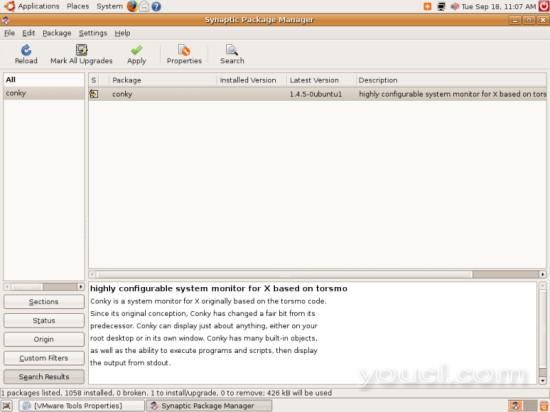
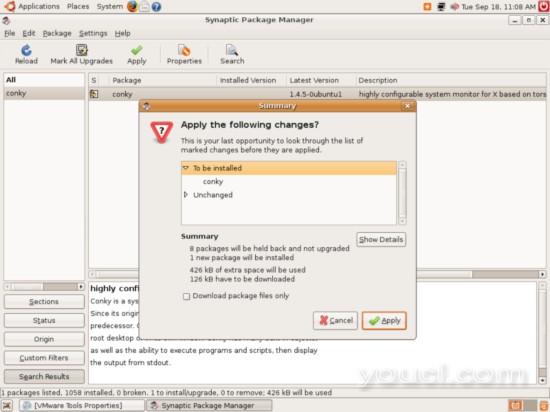
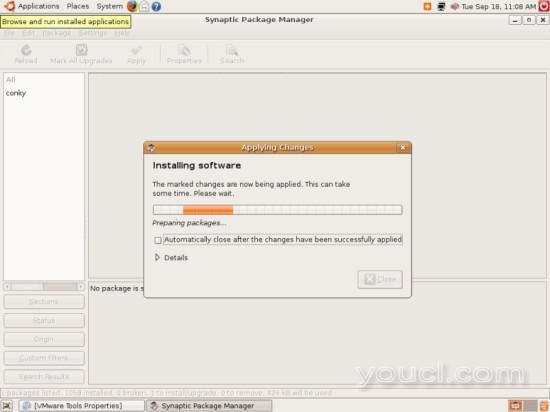
2.配置
有很多配置选项和预定义变量来定制Conky,我无法在这里列出和解释。 一个很好的文档,包括联机帮助页,常见问题解答,Conky变量列表和Conky配置文件设置列表,可从http://conky.sourceforge.net/获得 。
在某些情况下,Conky有一个闪烁的问题。 如果你的机器上有这个问题,你应该看一下FAQ - 有解决方法来解决这个问题。
打开终端并为Conky创建配置文件。
使用默认configutaion:
zcat /usr/share/doc/conky/examples/conkyrc.sample.gz > ~/.conkyrc
或使用我的配置:
vi .conkyrc
# Conky sample configuration
#
# the list of variables has been removed from this file in favour
# of keeping the documentation more maintainable.
# Check http://conky.sf.net for an up-to-date-list.
# set to yes if you want Conky to be forked in the background
background no
# X font when Xft is disabled, you can pick one with program xfontsel
#font 5x7
#font 6x10
#font 7x13
#font 8x13
#font 9x15
#font *mintsmild.se*
#font -*-*-*-*-*-*-34-*-*-*-*-*-*-*
font arial
# Use Xft?
use_xft no
# Xft font when Xft is enabled
xftfont Bitstream Vera Sans Mono:size=8
# Text alpha when using Xft
xftalpha 0.8
# Print everything to stdout?
# out_to_console no
# MPD host/port
# mpd_host localhost
# mpd_port 6600
# mpd_password tinker_bell
# Print everything to console?
# out_to_console no
# mail spool
mail_spool $MAIL
# Update interval in seconds
update_interval 5.0
# This is the number of times Conky will update before quitting.
# Set to zero to run forever.
total_run_times 0
# Create own window instead of using desktop (required in nautilus)
own_window yes
# If own_window is yes, you may use type normal, desktop or override
own_window_type override
# Use pseudo transparency with own_window?
own_window_transparent yes
# If own_window_transparent is set to no, you can set the background colour here
own_window_colour hotpink
# If own_window is yes, these window manager hints may be used
#own_window_hints undecorated,below,sticky,skip_taskbar,skip_pager
own_window_hints undecorated,below,sticky
# Use double buffering (reduces flicker, may not work for everyone)
double_buffer yes
# Minimum size of text area
minimum_size 280 5
# Draw shades?
draw_shades no
# Draw outlines?
draw_outline no
# Draw borders around text
draw_borders no
# Draw borders around graphs
draw_graph_borders yes
# Stippled borders?
stippled_borders 8
# border margins
border_margin 4
# border width
border_width 1
# Default colors and also border colors
default_color black
default_shade_color black
default_outline_color black
# Text alignment, other possible values are commented
#alignment top_left
alignment top_right
#alignment bottom_left
#alignment bottom_right
#alignment none
# Gap between borders of screen and text
# same thing as passing -x at command line
gap_x 12
gap_y 35
# Subtract file system buffers from used memory?
no_buffers yes
# set to yes if you want all text to be in uppercase
uppercase no
# number of cpu samples to average
# set to 1 to disable averaging
cpu_avg_samples 2
# number of net samples to average
# set to 1 to disable averaging
net_avg_samples 2
# Force UTF8? note that UTF8 support required XFT
override_utf8_locale no
# Add spaces to keep things from moving about? This only affects certain objects.
use_spacer no
# Allow each port monitor to track at most this many connections (if 0 or not set, default is 256)
#max_port_monitor_connections 256
# Maximum number of special things, e.g. fonts, offsets, aligns, etc.
#max_specials 512
# Maximum size of buffer for user text, i.e. below TEXT line.
#max_user_text 16384
# variable is given either in format $variable or in ${variable}. Latter
# allows characters right after the variable and must be used in network
# stuff because of an argument
# stuff after 'TEXT' will be formatted on screen
TEXT
$color $nodename - $sysname $kernel on $machine
$hr
Uptime:${color #606060} $uptime $color - Load:${color #606060} $loadavg
$color CPU Usage:${color #606060} $cpu% ${cpubar}
${color #606060} ${cpugraph 0000ff 00ec00}
$color RAM Usage:${color #606060} $mem/$memmax - $memperc% ${membar}
$color Swap Usage:${color #606060} $swap/$swapmax - $swapperc% ${swapbar}
$color Processes:${color #606060} $processes $color Running:${color #606060} $running_processes
$color$hr
Networking:
Down:${color #606060} ${downspeed eth0} k/s$color ${offset 80}Up:${color #606060} ${upspeed eth0} k/s
${color #606060}${downspeedgraph eth0 32,150 ff0000 0000ec} ${upspeedgraph eth0 32,150 0000ff ec0000}
$color File systems: / ${color #606060}${fs_used /}/${fs_size /} ${fs_bar /}
$color Name PID CPU% MEM%
${color #ec0000} ${top name 1} ${top pid 1} ${top cpu 1} ${top mem 1}
${color #606060} ${top name 2} ${top pid 2} ${top cpu 2} ${top mem 2}
${top name 3} ${top pid 3} ${top cpu 3} ${top mem 3}
${top name 4} ${top pid 4} ${top cpu 4} ${top mem 4}
$color Mem usage
${color #ec0000} ${top_mem name 1} ${top_mem pid 1} ${top_mem cpu 1} ${top_mem mem 1}
${color #606060} ${top_mem name 2} ${top_mem pid 2} ${top_mem cpu 2} ${top_mem mem 2}
${top_mem name 3} ${top_mem pid 3} ${top_mem cpu 3} ${top_mem mem 3}
$color$hr
Connections in:${color #606060} ${tcp_portmon 1 32767 count}$color Connections out:${color #606060} ${tcp_portmon 32768 61000 count}$color Total:${color #606060} ${tcp_portmon 1 65535 count}
$color Inbound Connection ${alignr} Local Service/Port
${color #606060} ${tcp_portmon 1 32767 rhost 0} ${alignr} ${tcp_portmon 1 32767 lservice 0}
${tcp_portmon 1 32767 rhost 1} ${alignr} ${tcp_portmon 1 32767 lservice 1}
${tcp_portmon 1 32767 rhost 2} ${alignr} ${tcp_portmon 1 32767 lservice 2}
${tcp_portmon 1 32767 rhost 3} ${alignr} ${tcp_portmon 1 32767 lservice 3}
${tcp_portmon 1 32767 rhost 4} ${alignr} ${tcp_portmon 1 32767 lservice 4}
${tcp_portmon 1 32767 rhost 5} ${alignr} ${tcp_portmon 1 32767 lservice 5}
$color Outbound Connection ${alignr} Remote Service/Port$color
${color #606060} ${tcp_portmon 32768 61000 rhost 0} ${alignr} ${tcp_portmon 32768 61000 rservice 0}
${tcp_portmon 32768 61000 rhost 1} ${alignr} ${tcp_portmon 32768 61000 rservice 1}
${tcp_portmon 32768 61000 rhost 2} ${alignr} ${tcp_portmon 32768 61000 rservice 2}
${tcp_portmon 32768 61000 rhost 3} ${alignr} ${tcp_portmon 32768 61000 rservice 3}
${tcp_portmon 32768 61000 rhost 4} ${alignr} ${tcp_portmon 32768 61000 rservice 4}
${tcp_portmon 32768 61000 rhost 5} ${alignr} ${tcp_portmon 32768 61000 rservice 5}
$color$hr
Menulauncher
要使Conky可以从应用程序菜单访问,我们创建一个启动器。 首先右键单击菜单栏,然后选择编辑菜单 :
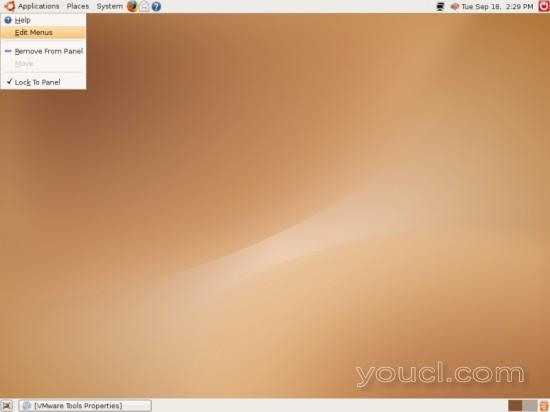
在左侧的新弹出窗口中选择系统工具 :
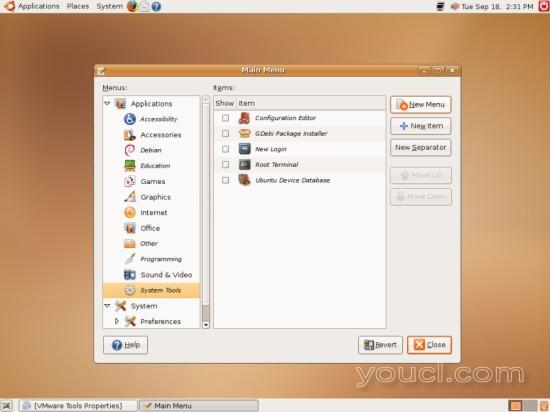
单击右侧的新建项目以创建新的启动器。 插入/选择以下内容:
类型: 应用
名字: Conky
命令: conky
评论:如果你想要插入评论。
图标:如果需要,请选择一个。
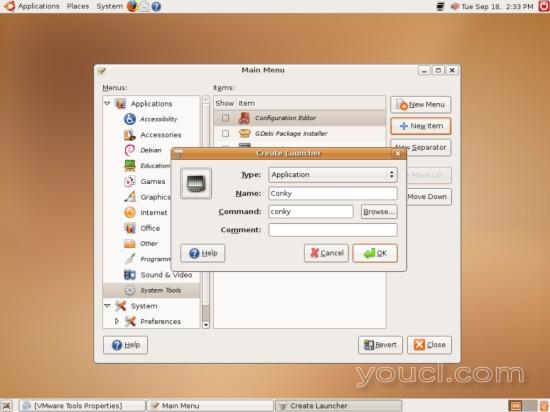
现在您可以通过应用程序菜单启动Conky:
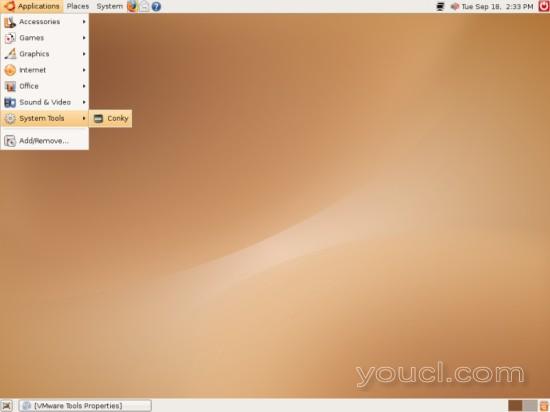
如果您在第2步选择了我的配置,应该如下所示:
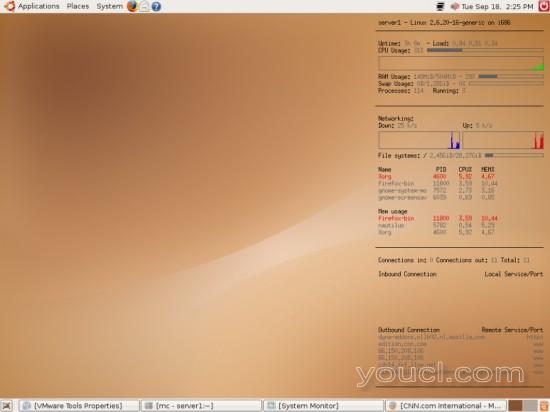
4链接
- Conky: http : //conky.sourceforge.net/
- Ubuntu: http : //www.ubuntu.com/








